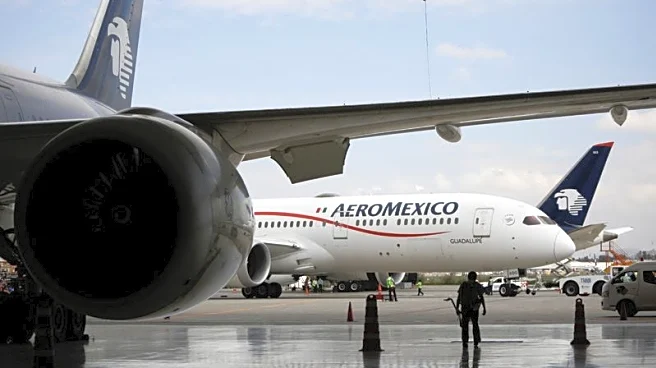What's Happening?
American Airlines is grappling with a significant debt burden of $36.8 billion, which poses a substantial challenge to its financial stability. Despite reporting a net income of $846 million on $53 billion in revenue
last year, the airline's debt remains considerably higher than its competitors. Delta Air Lines, for instance, holds $15.6 billion in debt and reported over $4 billion in profit, while United Airlines has $25 billion in debt with similar profitability. American Airlines' financial struggles are compounded by its reliance on its loyalty program for profitability, as it continues to lose money from its core operations of flying passengers and cargo. The airline's management, led by CEO Robert Isom, has been attempting to cut costs and focus on premium markets to improve financial performance. However, the airline's ability to meet its debt obligations remains uncertain, with plans to reduce the debt to $35 billion by the end of 2027.
Why It's Important?
The financial health of American Airlines is crucial not only for its stakeholders but also for the broader U.S. airline industry. The airline's substantial debt load could impact its ability to invest in new technologies, improve customer service, and expand its route network. This situation may also affect the airline's competitiveness against rivals like Delta and United, which have stronger financial positions. Additionally, the airline's financial struggles could have implications for its employees, suppliers, and the communities it serves. If American Airlines fails to manage its debt effectively, it could face increased borrowing costs or even potential restructuring, which would have significant repercussions for the industry and the economy.
What's Next?
American Airlines plans to reduce its debt by $1.8 billion over the next five quarters, but this goal is contingent on the airline's ability to generate sufficient profits. The airline's management will need to execute its cost-cutting strategies effectively and capitalize on its premium market focus to achieve this target. Investors and industry analysts will be closely monitoring the airline's financial performance and strategic initiatives in the coming quarters. Any failure to meet debt reduction targets could lead to increased scrutiny from shareholders and potential changes in management or strategy.
Beyond the Headlines
The situation at American Airlines highlights broader issues within the airline industry, such as the reliance on loyalty programs for profitability and the challenges of managing high debt levels. The airline's struggles also underscore the importance of effective management and strategic planning in navigating financial challenges. As the industry continues to recover from the impacts of the pandemic, airlines will need to balance cost management with investments in customer experience and operational efficiency to remain competitive.












